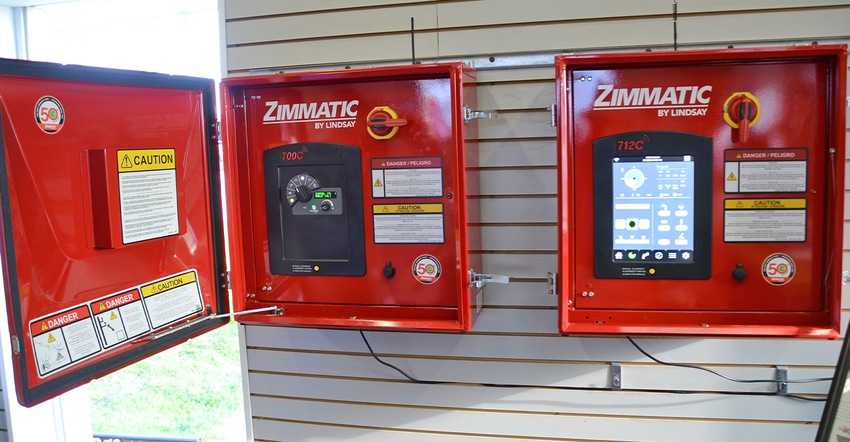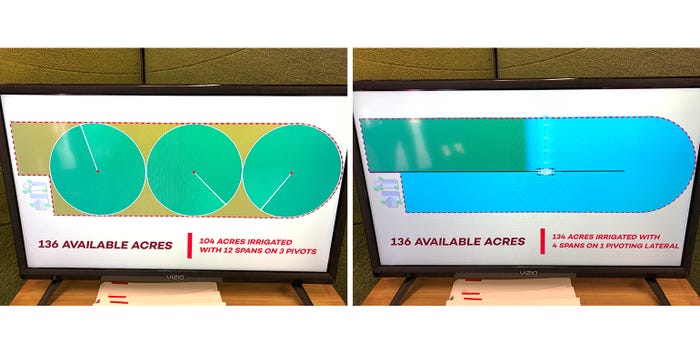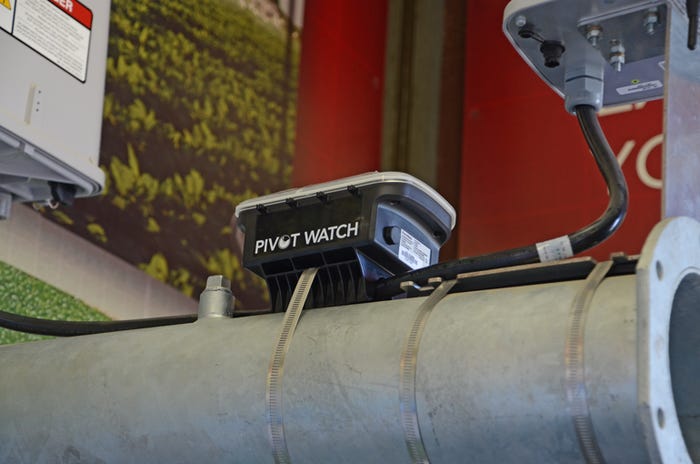September 26, 2019

Fall is a time when many irrigation firms roll out new tools. For Lindsay, the Zimmatic line is getting several new products, from a new set of controllers to enhanced crop management tools for its FieldNET system.
“What we have is a new-generation controller lineup,” explains Reece Andrews, product manager for FieldNET products, Lindsay.
He notes the company is launching three new controllers — the 500C, 700C and 712C. The innards for the three controllers are essentially the same rugged build to manage a pivot. The front, however, is a little different in each. The 500C and 700C look the same with a selector knob for specific pivot actions, while the712C has a 12-inch monitor for on-controller programming.
All three can be managed from the company’s FieldNET system. “The 500C doesn’t have GPS,” Andrews says, and many growers don’t need the positioning system to manage the pivot. Stepping up to the 700C brings GPS.
Managing the controller remotely is simple using the FieldNET system, he adds, though some operators like to visit the box and get in touch with the controls. “I don’t need to be at the box to get things done correctly,” he says.
‘Smart barrier’ automation
The new controllers feature what the company is calling “smart barrier” automation, which provides a simple way to control a pivot for a partial circle, enabling the pivot to automatically reverse and stop at the original starting point.
“We’re seeing more partial field irrigation systems,” Andrews says. “All the full circles, the easy fields, have been done. So now we’re irrigating the harder fields, that are more irregular. We wanted to enhance the customer experience with the part-circle machines and the power that they have.”
Andrews notes that for many systems, if you irrigate in a part circle, there are physical barriers at the edges of the field, which you can use to manage the pivot’s direction. “We did something new. We’re going to call them smart barriers. These are areas of nonapplication, and I can set something up that is a different action at each of those barriers.”
This system doesn’t involve physical barriers, and that software approach means the pivot could stop when it reaches a barrier and return to start at a different speed — or another approach the user programs.
Andrews adds that a new feature for these controllers is the ability to get updates over the air. This is a feature that started in 2015 and is now standard for the new controllers.
The controllers also have added input and output ports to provide flexibility for adding other accessories and sensors.
That 712C panel with its 12-inch monitor is designed to mimic FieldNET software for users in the field, Andrews says. He offers the example of a Washington grower testing the system who was asked how long it took him to use the new interactive panel. “He said, ‘About three seconds,’” Andrews says. “He thought we had an iPad in the panel running FieldNET — it was that familiar.” This is a ruggedized panel for severe service use, since the panel will be out in the elements year-round.

2 images comparing coverage of conventional pivot and lateral pivot irrigation
COVER MORE GROUND: Lindsay launches the Zimmatic 9520 PL Pivoting Lateral to cover more acres. The image on the left shows a field using pivots, while the one on the right shows the enhanced coverage offered by the pivoting lateral.

2 images comparing coverage of conventional pivot and lateral pivot irrigation
Managing odd field sizes
Smart barriers on the new control panels help farmers manage pivots working in non-full-circle environments, but what about more unique field shapes? There, the answer is the new Zimmatic 9520PL Pivoting Lateral that allows farmers to irrigate more land with greater flexibility.
“When you start with a traditional lateral, you just have a rectangular shaped field, so you can go up and down the regular-shape field,” Andrews says. “But you can’t get around some odd shapes, or water those edges.”
The Zimmatic Pivoting Lateral can run in a straight line, and then pivot at the end and return. This allows more coverage of lengthy fields. The system is designed to move along a field and be connected to specific hydrants along the course, and it provides a more efficient coverage solution than three pivots in a single field.
The 9520PL will launch by the end of 2019 and is best-suited for high-value crops on large, irregularly shaped fields, where a center-pivot or lateral-move system may not make financial sense.
A better crop model
FieldNET Advisor is a system that can be used to program the right amount of water to specific crops using weather information, soil type and other details to build an irrigation model.
Albert Maurin, product manager, Lindsay, explains that the system now works with 25 supported crops. “We also integrated satellite imagery, and with your FieldNET Advisor subscription, you can receive regular imagery so you can see trends in your field; you can see places that are maybe healthier or less healthy,” he says.

KICK IT UP A NOTCH: For some crops, a faster-moving pivot offers irrigators more options for managing water and crop health. The new Zimmatic 9500HS hits the market this fall and offers the ability to move at twice the normal speed.

The system can spot problems with your sprinkler system before too much crop damage occurs. The eight new beta crops added to this automated scheduling tool include canola, carrots, mint, oats, onions, pasture for forage – first year and established, and sweet potatoes. And the FieldNET mobile app also got an upgrade.
The adviser system from FieldNET can improve water use efficiency, too. “If you’re using a traditional method of point-source measuring, like a soil moisture probe or hand feel, you’re going to understand the available water to that particular part of the field,” Maurin explains.
He explains that FieldNET Advisor can use information like soil moisture-holding capacity, weather and crop type to predict how much water the crop needs.

SIMPLE TELEMETRY: Not every pivot in the field has high-end telemetry systems installed. Farmers can overcome a lot of that, however, with the Zimmatic Pivot Watch. Its solar-charged battery simply attaches to the pivot and provides GPS-indexed telemetry that growers can use to manage pivots.

The need for speed and more
Placing water precisely sometimes means moving faster. Zimmatic is answering that with the 9500HS High Speed pivot that will allow growers to operate at up to twice the speed of a standard center-drive motor. This tech is suited for root crops including potatoes, carrots, onions, sugarbeets and alfalfa.
And the company offers the FieldNET Pivot Watch, which is a remote management product for the irrigator who wants a monitor-only solution. “There’s a huge installed base of pivots without telemetry on board,” says Maurin. “The Pivot Watch is a low-cost, monitor-only solution compatible with all brands of electric and hydraulic center pivots.”
The system is battery-powered and kept charged with a small solar panel on top. “This can be a do-it-yourself install by the grower. It has onboard GPS and a cellular [connection] for remote telemetry from the field. There is nothing wired to the pivot itself.”
You can get more information about all these new products by visiting zimmatic.com.
About the Author(s)
You May Also Like






